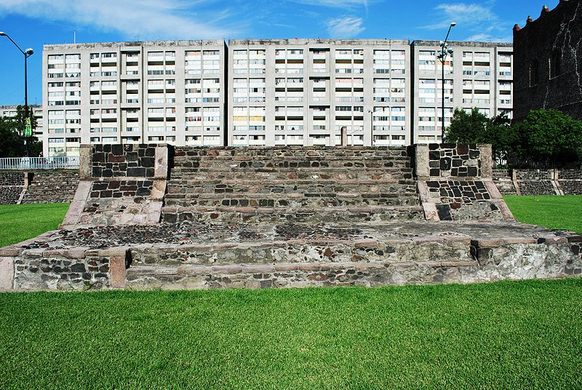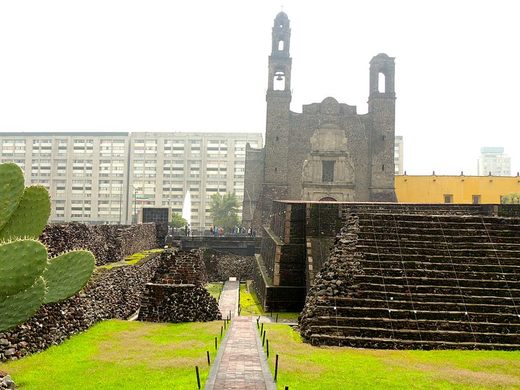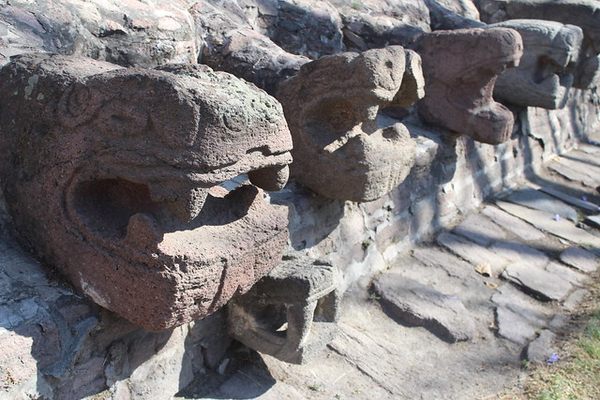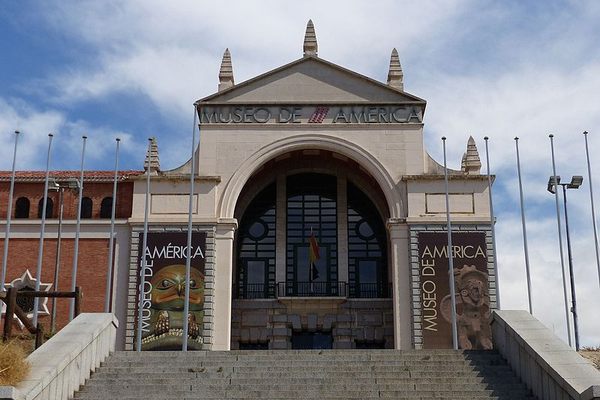Pyramids of Tlatelolco
These haunting ruins of a 700-year-old Prehispanic city have witnessed centuries of wars and massacres.
In the Plaza de las Tres Culturas with its disorientating juxtaposition of modern, colonial, and ancient architecture sprawl the hallowed stone ruins of a Prehispanic city replete with pyramids. Today, you may visit the mysterious ruins of Tlatelolco and wander the ancient pathways in the shadows of the pyramids.
Early in the history of the Aztec colonization of the Valley of Mexico, there was a dissident group that had separated from the main party of nomads to found a settlement elsewhere. This group called themselves the Tlatelolca and set about building the city that later would become Tlatelolco approximately 700 years ago.
The site remained as a semi independent settlement that held a degree of autonomy from the Aztec city of Tenochtitlan for many years. The Tlatelolca traded heavily with the Aztecs and provided an important source of resources for the growing power.
This peaceful coexistence continued until the Tlatelolca, in response to threats, declared their outright independence. This angered the Aztec emperor Axayacatl, who promptly sent out battalions of his eagle and jaguar warriors to force the city into submission. The Tlatelolca people were then promptly crushed in a brutal military campaign, which brought the population under the complete control of the Aztec empire for the rest of its history and the city was quickly incorporated as part of the capital Tenochtitlan.
That wasn’t the only turmoil the city would face. In 1521, the Spanish conquest sent shockwaves through Tlatelolco with the arrival of Hernán Cortés and his conquistadors in the valley of Mexico. As subjects of the Aztec Empire, the Tlatelolca formed part of the Aztec resistance to the Spaniards and fought them fiercely, refusing to surrender until the fugitive Aztec emperor Cuauhtémoc was captured. As such, the site was the setting for many bloody battles between the Spanish and the indigenous people.
Shortly after the conquest of Mexico, the surviving populace of Tlatelolco were further decimated by several pandemics of smallpox, influenza, and hemorrhagic fever. As the indigenous peoples of the Americas had no immunity to the viruses that swept through the area these viruses were especially deadly and went on to kill thousands of men, women, and children.
In the wake of this genocide, the nearly deserted city was repopulated by the Aztec survivors of the siege of Tenochtitlan, who the Spanish had forcibly removed from the crumbling ruins of their city. Many of the resettled survivors were ordered to build the Catholic church (which now overshadows the ruins) using the stones from the old temples.
The ruins of the city lay forgotten under the pavement of the plaza until 1900, when constructions to build a new drainage system unearthed the pyramids. This discovery prompted the prominent Mexican archeologist Leopoldo Batres and his son to excavate the site. They made subsequent other discoveries, including skeletons that are now housed in the National Museum of Anthropology. Decades later, the skeletons of a man and a woman seemingly holding hands were unearthed and dubbed “the lovers of Tlatelolco.”
In 2009, another new and shocking discovery surfaced. Archaeologists found a mass grave containing the remains of more than 50 adult men. Analysis revealed that the grave dated from the period of the Spanish conquest and that most of the skeletons belonged to young men who were in their early to mid-20s. Judging by their many broken and re-healed bones, they were probably Aztec warriors.
Various theories have been put forward as to how these men died, but the most probable explanation is that they were prisoners of the Spanish who were, for unknown reasons, kept alive for a short period before being executed and buried in a mass grave.
Know Before You Go
The archeological site and its museum is open every day from 8:00 a.m. to 6:00 p.m. and the entrance fee costs 40 pesos.
Get to Tlatelolco via the Mexico City metro. Take line 3 (Olive green line) all the way to the station Tlaltelolco (which conveniently has a pyramid symbol). Upon leaving the station, take a right and walk down the "Manuel Gonzalez Avenue" then take a walk down the "Eje Central Lazaro Cardenas" road, where you will reach the "Plaza de las Tres Culturas."






















Follow us on Twitter to get the latest on the world's hidden wonders.
Like us on Facebook to get the latest on the world's hidden wonders.
Follow us on Twitter Like us on Facebook